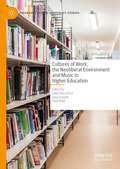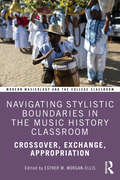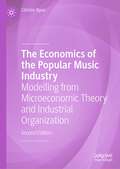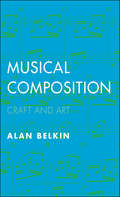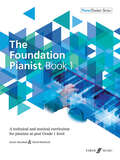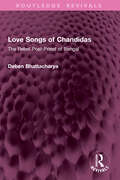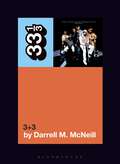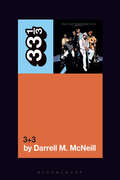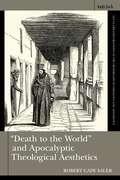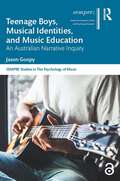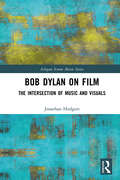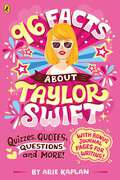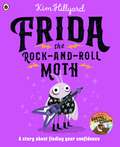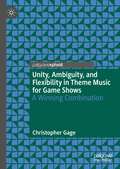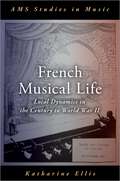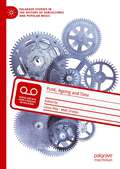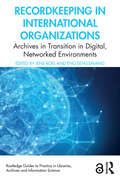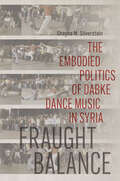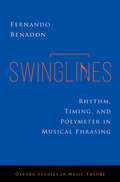- Table View
- List View
Cultures of Work, the Neoliberal Environment and Music in Higher Education (Palgrave Critical University Studies)
by Sally Macarthur Julja Szuster Paul WattThis edited book considers the impact of neoliberalism on music teaching, research and scholarship in a higher education context. As a subject that bears little resemblance to other university practical disciplines, and fares poorly in a model driven by economics, the book considers whether musicology is a ‘public good’ or a threatened species. It contemplates what musicology can usefully contribute to a paradigm driven by economics, and questions whether it is ever possible to recover an ideal civil subject in neoliberal music academia. Contributions investigate what it means to build music research capacity in innovative ways, such as forging cross-cultural relationships, subverting conventional notions of quality and value, replacing them with knowledges and values that guide Indigenous intellectual traditions, and whether interventions into the legacy of colonialism are truly ever possible in neoliberal higher education institutions that celebrate difference and diversitywhile reinforcing social inequities. The book also explores the relationships between gender and music, music research training and scholarship, and whether the interdisciplinarity championed by the university is ever workable. Finally, it undertakes a cross-disciplinary, new materialist reading of a canonical musical work, offering a radically new perspective. The book will appeal to students and scholars of music education, musicology, higher education studies and the creative arts more broadly.
Navigating Stylistic Boundaries in the Music History Classroom: Crossover, Exchange, Appropriation (Modern Musicology and the College Classroom)
by Esther M. Morgan-EllisAt a time of transformation in the music history classroom and amid increasing calls to teach a global music history, Navigating Stylistic Boundaries in the Music History Classroom adds nuance to the teaching of varied musical traditions by examining the places where they intersect and the issues of musical exchange and appropriation that these intersections raise. Troubling traditional boundaries of genre and style, this collection of essays helps instructors to denaturalize the framework of Western art music and invite students to engage with other traditions—vernacular, popular, and non-Western—on their own terms.The book draws together contributions by a wide range of active scholars and educators to investigate the teaching of music history around cases of stylistic borders, exploring the places where different practices of music and values intersect. Each chapter in this collection considers a specific case in which an artist or community engages in what might be termed musical crossover, exchange, or appropriation and delves deeper into these concepts to explore questions of how musical meaning changes in moving across worlds of practice. Addressing works that are already widely taught but presenting new ways to understand and interpret them, this volume enables instructors to enrich the perspectives on music history that they present and to take on the challenge of teaching a more global music history without flattening the differences between traditions.
Navigating Stylistic Boundaries in the Music History Classroom: Crossover, Exchange, Appropriation (Modern Musicology and the College Classroom)
At a time of transformation in the music history classroom and amid increasing calls to teach a global music history, Navigating Stylistic Boundaries in the Music History Classroom adds nuance to the teaching of varied musical traditions by examining the places where they intersect and the issues of musical exchange and appropriation that these intersections raise. Troubling traditional boundaries of genre and style, this collection of essays helps instructors to denaturalize the framework of Western art music and invite students to engage with other traditions—vernacular, popular, and non-Western—on their own terms.The book draws together contributions by a wide range of active scholars and educators to investigate the teaching of music history around cases of stylistic borders, exploring the places where different practices of music and values intersect. Each chapter in this collection considers a specific case in which an artist or community engages in what might be termed musical crossover, exchange, or appropriation and delves deeper into these concepts to explore questions of how musical meaning changes in moving across worlds of practice. Addressing works that are already widely taught but presenting new ways to understand and interpret them, this volume enables instructors to enrich the perspectives on music history that they present and to take on the challenge of teaching a more global music history without flattening the differences between traditions.
The Economics of the Popular Music Industry: Modelling from Microeconomic Theory and Industrial Organization
by Christie ByunThis book uses economic theory to explain how consumers and producers have responded to major changes in the music industry. Byun examines the important role of technology in changing its structure, particularly as new methods of creating and accessing music prove to be a double-edged sword for creators and producers. This second edition includes new information about concert attendance and live performance in the COVID era and what followed, as well as the resultant economic impacts on the industry. Throughout the book, Byun questions how the business of music affects creativity and the extent to which this impacts the creative output of the individual artist. Chapters also address copyright enforcement and online piracy. This is an approachable resource for economists interested in the music industry as well as business and music majors studying the ways in which technology can impact a creative process.
Musical Composition: Craft and Art
by Alan BelkinAn invaluable introduction to the art and craft of musical composition from a distinguished teacher and composerThis essential introduction to the art and craft of musical composition is designed to familiarize beginning composers with principles and techniques applicable to a broad range of musical styles, from concert pieces to film scores and video game music. The first of its kind to utilize a style-neutral approach, in addition to presenting the commonly known classical forms, this book offers invaluable general guidance on developing and connecting musical ideas, building to a climax, and other fundamental formal principles. It is designed for both classroom use and independent study.
The Foundation Pianist Book 1: A Technical and Musical Curriculum for Pianists at Post Grade 1 Level (Faber Edition: Piano Trainer #Bk 1)
by Karen Marshall David BlackwellThe Foundation Pianist is a set of two books by David Blackwell and Karen Marshall for students beyond the beginner stage who want to develop a technical and musical foundation to help them progress on to intermediate levels. Exploring piano technique through a variety of elements, the books include daily exercises, sight-reading, repertoire and musical time travel. This series not only develops students’ technique, reading, theory and musicianship, but also provides an invaluable insight into the world of classical music, from madrigals to symphonies and operas to concertos. The Foundation Pianist Book 1 forms part of the PianoTrainer series.
Love Songs of Chandidas: The Rebel Poet-Priest of Bengal (Routledge Revivals)
First published in 1967, Love Songs of Chandidās provides an informative introduction which makes vividly clear the importance of Chandidās to the Indian peasant masses. As the author tells us, the traveller through the Birbhum area of Bengal hears Chandidās everywhere, in the villages, in the fields, on the roads. Night after night, the people gather in the temple courtyards or on the village greens to listen to professional ‘Kirtan’ singers sing his songs of the divine love of Radha and Krishna. The influence of Chandidās on contemporary Bengali literature is equally important, his songs having enriched the work of great poets such as Rabindranath Tagore, Govindadas, and many others. The author also discusses the interesting topic of the Sahaja (‘spontaneity’) movement in Indian faith and literature, as manifested in the songs of Chandidās, and the worship of love-making, divine and human, as an important aspect of this faith. This book will be of interest to students of literature, music, history, cultural studies and South Asian studies.
Love Songs of Chandidas: The Rebel Poet-Priest of Bengal (Routledge Revivals)
by Deben BhattacharyaFirst published in 1967, Love Songs of Chandidās provides an informative introduction which makes vividly clear the importance of Chandidās to the Indian peasant masses. As the author tells us, the traveller through the Birbhum area of Bengal hears Chandidās everywhere, in the villages, in the fields, on the roads. Night after night, the people gather in the temple courtyards or on the village greens to listen to professional ‘Kirtan’ singers sing his songs of the divine love of Radha and Krishna. The influence of Chandidās on contemporary Bengali literature is equally important, his songs having enriched the work of great poets such as Rabindranath Tagore, Govindadas, and many others. The author also discusses the interesting topic of the Sahaja (‘spontaneity’) movement in Indian faith and literature, as manifested in the songs of Chandidās, and the worship of love-making, divine and human, as an important aspect of this faith. This book will be of interest to students of literature, music, history, cultural studies and South Asian studies.
The Isley Brothers' 3+3 (33 1/3)
by Darrell M. McNeillThe Isley Brothers' 3+3, dissects The Isleys' 50-year-old undisputed masterwork, an album that firmly established their music dynasty on a global scale, as well as heralding the boldest run of genre-defiant albums of their 67-year career. The 1973 watershed was their first multiplatinum release and is significant as a rare, crossover record by a Black act that struck a chord with urban, rock, and pop consumers, despite the schisms between audiences due to bias-driven media and industry marketing.The book looks at the album from all angles: from The Isleys' early career to their influence on rock and rollers both Black and White, from the twists and turns of having national hits without national recognition, on to their decision to form T-Neck Records and the group's challenges navigating a music industry that racially codified music and hampered Black artists from universal acclaim and compensations. Finally, a summation of the decades follows The Isleys' run and its ups and downs, with a fast-forward to where the group is now after 67 years.
The Isley Brothers' 3+3 (33 1/3)
by Darrell M. McNeillThe Isley Brothers' 3+3, dissects The Isleys' 50-year-old undisputed masterwork, an album that firmly established their music dynasty on a global scale, as well as heralding the boldest run of genre-defiant albums of their 67-year career. The 1973 watershed was their first multiplatinum release and is significant as a rare, crossover record by a Black act that struck a chord with urban, rock, and pop consumers, despite the schisms between audiences due to bias-driven media and industry marketing.The book looks at the album from all angles: from The Isleys' early career to their influence on rock and rollers both Black and White, from the twists and turns of having national hits without national recognition, on to their decision to form T-Neck Records and the group's challenges navigating a music industry that racially codified music and hampered Black artists from universal acclaim and compensations. Finally, a summation of the decades follows The Isleys' run and its ups and downs, with a fast-forward to where the group is now after 67 years.
"Death to the World" and Apocalyptic Theological Aesthetics (T&T Clark Explorations at the Crossroads of Theology and Aesthetics)
by Robert Cady SalerRobert Saler examines the small but influential Death to the World movement in US Eastern Orthodox Christianity. Presenting a case study in theological aesthetics, Saler demonstrates how a relatively small consumer phenomenon within US Eastern Orthodoxy sits at the centre of a variety of larger questions, including:- The relationship between formal ecclesial and para-church structures - The role of the Internet in modern religiosity - Consumer structures and patterns as constitutive of piety- How theology can help us understand art and vice versaUnderstanding "Death to the World" as an instance of lived religion tied to questions of identity, politics of religious purity, relationships to capitalism, and concerns over conspiracy theory helps us to see how studies of uniquely American Eastern Orthodox identity must address these broader cultural strands.
"Death to the World" and Apocalyptic Theological Aesthetics (T&T Clark Explorations at the Crossroads of Theology and Aesthetics)
by Robert Cady SalerRobert Saler examines the small but influential Death to the World movement in US Eastern Orthodox Christianity. Presenting a case study in theological aesthetics, Saler demonstrates how a relatively small consumer phenomenon within US Eastern Orthodoxy sits at the centre of a variety of larger questions, including:- The relationship between formal ecclesial and para-church structures - The role of the Internet in modern religiosity - Consumer structures and patterns as constitutive of piety- How theology can help us understand art and vice versaUnderstanding "Death to the World" as an instance of lived religion tied to questions of identity, politics of religious purity, relationships to capitalism, and concerns over conspiracy theory helps us to see how studies of uniquely American Eastern Orthodox identity must address these broader cultural strands.
Teenage Boys, Musical Identities, and Music Education: An Australian Narrative Inquiry (ISSN)
by Jason GoopyMusic is a powerful process and resource that can shape and support who we are and wish to be. The interaction between musical identities and learning music highlights school music education’s potential contributions and responsibilities, especially in supporting young people’s mental health and well-being. Through the distinctive stories and drawings of Aaron, Blake, Conor, Elijah, Michael, and Tyler, this book reveals the musical identities of teenage boys in their final year of study at an Australian boys’ school.This text serves as an interface between music, education, and psychology using narrative inquiry. Previous research in music education often seeks to generalise boys, whereas this study recognises and celebrates the diverse individual voices of students where music plays a significant role in their lives. Adolescent boys’ musical identities are examined using the theories of identity work and possible selves, and their underlying music values and uses are considered important guiding principles and motivating goals in their identity construction. A teaching and learning framework to shape and support multiple musical identities in senior secondary class music is presented.The relatable and personal stories in this book will appeal to a broad readership, including music teachers, teacher educators, researchers, and readers interested in the role of music in our lives. Creative and arts-based research methods, including narrative inquiry and innovative draw and tell interviews, will be particularly relevant for research method courses and postgraduate research students.
Teenage Boys, Musical Identities, and Music Education: An Australian Narrative Inquiry (ISSN)
by Jason GoopyMusic is a powerful process and resource that can shape and support who we are and wish to be. The interaction between musical identities and learning music highlights school music education’s potential contributions and responsibilities, especially in supporting young people’s mental health and well-being. Through the distinctive stories and drawings of Aaron, Blake, Conor, Elijah, Michael, and Tyler, this book reveals the musical identities of teenage boys in their final year of study at an Australian boys’ school.This text serves as an interface between music, education, and psychology using narrative inquiry. Previous research in music education often seeks to generalise boys, whereas this study recognises and celebrates the diverse individual voices of students where music plays a significant role in their lives. Adolescent boys’ musical identities are examined using the theories of identity work and possible selves, and their underlying music values and uses are considered important guiding principles and motivating goals in their identity construction. A teaching and learning framework to shape and support multiple musical identities in senior secondary class music is presented.The relatable and personal stories in this book will appeal to a broad readership, including music teachers, teacher educators, researchers, and readers interested in the role of music in our lives. Creative and arts-based research methods, including narrative inquiry and innovative draw and tell interviews, will be particularly relevant for research method courses and postgraduate research students.
FL Studio Cookbook: The lofi, retrowave, and horror music chef's guide to FL Studio music production
by Chris RenaElevate your music production skills with expert help and confidently create unique melodies, soundscapes, and fully mastered tracksKey FeaturesExplore FL Studio's essential features and plugins with expert guidance and a practical, recipe-based approachCreate captivating melodies for your tracks, then mix and master them like a professionalDelve deep into sound design techniques, automation, and FX creation for crafting dynamic music compositionsPurchase of the print or Kindle book includes a free PDF eBookBook DescriptionWhether it's overcoming creative blocks, troubleshooting technical issues, or refining your workflow, every budding producer faces challenges. The FL Studio Cookbook is here to provide practical solutions to common problems, empowering you to navigate any obstacle with ease by exploring one of the most renowned, industry-standard DAWs. The recipe-based approach of this book means that you’ll unlock the secrets of crafting captivating melodies and learn the art of composition with practical, step-by-step instructions, discovering how to construct melodies that evoke emotion and leave a lasting impression. From chord progressions to counterpoint, you’ll get actionable insights to help you compose music that resonates with your audience. You’ll also master the intricacies of mixing and mastering, by familiarizing yourself with the entire process from balancing levels and sculpting sounds to applying effects. You’ll also explore the endless possibilities of sculpting sound from scratch, whether you're crafting custom synths, designing unique textures, or layering effects to create otherworldly sounds. By the end of this book, you'll have acquired the skills to confidently craft professional-quality lofi, retrowave, and horror music tracks, gaining the expertise to express your musical vision and take your music production to new heights.What you will learnNavigate the FL Studio interface and utilize essential features effectivelyCraft captivating melodies, harmonies, and chord progressions for your musicManipulate samples to add depth and texture to your tracksMaster the art of mixing, including balancing levels, applying EQ, and using effectsHarness the potential of FL Studio's extensive plugin collectionCreate dynamic tracks using automation techniquesEmploy sound design techniques to craft unique sounds and FXOptimize your workflow and productivity with timesaving strategiesWho this book is forThe book is for audio professionals, especially music producers and sound designers who want to get a more thorough understanding of FL Studio and how to use its features to create catchy melodies for their productions. The book assumes a basic understanding of Digital Audio Workstations (DAWs), prior experience with the mix workflow (import, edit, mix, FX).
Bob Dylan on Film: The Intersection of Music and Visuals (Ashgate Screen Music Series)
by Jonathan HodgersIn May 1967, during a discussion about his yet-to-be-released film Eat the Document, Bob Dylan cryptically remarked, ‘The film is finished. It’s different.’ It would not be the last time he could make this claim. Beyond his musical prowess, Dylan’s career encompasses a lesser-explored facet – that of a filmmaker creating works that defy convention. This book delves into these cinematic forays, unravelling the intriguing interplay of Dylan’s presence both behind and in front of the camera.Dylan’s cinematic experiments, ranging from the ground-breaking Dont Look Back (1967) to the enigmatic Masked and Anonymous (2003), stand as unique and thought-provoking additions to his artistic legacy. Unveiling an experimental and inquisitive sensibility, these films draw inspiration not only from cinematic predecessors but also from Dylan’s songcraft. Often residing in the periphery of Dylan studies, a closer examination of his cinematic oeuvre reveals an underrated auteur who fearlessly transcends the boundaries of the page, stage, and screen.
Bob Dylan on Film: The Intersection of Music and Visuals (Ashgate Screen Music Series)
by Jonathan HodgersIn May 1967, during a discussion about his yet-to-be-released film Eat the Document, Bob Dylan cryptically remarked, ‘The film is finished. It’s different.’ It would not be the last time he could make this claim. Beyond his musical prowess, Dylan’s career encompasses a lesser-explored facet – that of a filmmaker creating works that defy convention. This book delves into these cinematic forays, unravelling the intriguing interplay of Dylan’s presence both behind and in front of the camera.Dylan’s cinematic experiments, ranging from the ground-breaking Dont Look Back (1967) to the enigmatic Masked and Anonymous (2003), stand as unique and thought-provoking additions to his artistic legacy. Unveiling an experimental and inquisitive sensibility, these films draw inspiration not only from cinematic predecessors but also from Dylan’s songcraft. Often residing in the periphery of Dylan studies, a closer examination of his cinematic oeuvre reveals an underrated auteur who fearlessly transcends the boundaries of the page, stage, and screen.
96 Facts About Taylor Swift: Quizzes, Quotes, Questions and More!
by Arie KaplanThe ultimate Taylor Swift fact and activity book for children!Discover everything any young Taylor Swift fan needs to know in this jam-packed guide, full of facts, quizzes and questions. Plus there are bonus journal pages to fill in.Did you know . . .?Taylor grew up on a Christmas-tree farmShe can play the piano, banjo and ukulele as well as the guitar!She won a poetry competition when she was 10This bumper illustrated book is perfect for any Swiftie!
Frida the Rock-and-Roll Moth: A story about finding your confidence
by Kim HillyardA NEW picture book from the winner of the Best Illustrated Book, Waterstones Children's Prize 2023.Frida is a musical moth who loves to rock out - she puts on her pointy boots and plays her purple guitar really LOUD! But when the Big Bright Light is switched on, more moths appear, ready to rock together, and Frida starts to feel that everyone is much better than her. Perhaps she isn't so rock-and-roll after all . . .With the help of her biggest fan, Auntie Edna, Frida learns to reclaim her style, find her confidence and get up and rock on once more!This positive picture book will inspire readers to find what makes them feel good and let their inner confidence shine.Kim Hillyard creates positive, heart-warming stories that are designed to empower and inspire young readers. Each picture book focuses on a different feeling or belief to help children navigate the world around them.Also available from Kim Hillyard:Mabel and the Mountain: a story about believing in yourselfNed and the Great Garden Hamster Race: a story about kindnessGretel The Wonder Mammoth: a story about overcoming anxietyFlora and Nora Hunt for Treasure: a story about the power of friendship
Unity, Ambiguity, and Flexibility in Theme Music for Game Shows: A Winning Combination
by Christopher GageWith flashing lights, bright colors, and big money, game shows have been an integral part of American culture since the days of radio. While the music that accompanies game shows is charming and catchy, it presents two unique, opposing challenges: first, it must exhibit unity in its construction so that, at any point and for any length of time, it is a tuneful, recognizable signifier of the show to which it belongs; at the same time, it must also possess the ability to be started and stopped according to the needs of gameplay without seeming truncated. This book argues that game show music, in particular from 1960 to 1990, deploys a variety of shared techniques in order to manage these two goals, including theme-derived vamps; saturation of motivic material; and harmonic, rhythmic, and formal ambiguity. Together, these techniques make game show themes exciting, memorable, and perfectly suited to their role.
French Musical Life: Local Dynamics in the Century to World War II (AMS Studies in Music)
by Katharine EllisExplicitly or not, the historical musicology of post-Revolutionary France has focused on Paris as a proxy for the rest of the country. This distorting lens is the legacy of political and cultural struggle during the long nineteenth century, indicating a French Revolution unresolved both then and now. In light of the capital's power as the seat of a centralizing French state (which provincials found 'colonizing') and as a cosmopolitan musical crossroads of nineteenth-century Europe, the struggles inherent in creating sustainable musical cultures outside Paris, and in composing local and regionalist music, are ripe for analysis. Replacement of 'France' with Paris has encouraged normative history-writing articulated by the capital's opera and concert life. Regional practices have been ignored, disparaged or treated piecemeal. This book is a study of French musical centralization and its discontents during the period leading up to and beyond the "provincial awakening" of the Belle ?poque. The book explains how different kinds of artistic decentralization and regionalism were hard won (or not) across a politically turbulent century from the 1830s to World War II. In doing so it redraws the historical map of musical power relations in mainland France. Based on work in over 70 archives, chapters on conservatoires, concert life, stage music, folk music and composition reveal how tensions of State and locality played out differently depending on the structures and funding mechanisms in place, the musical priorities of different communities, and the presence or absence of galvanizing musicians. Progressively, the book shifts from musical contexts to musical content, exploring the pressure point of folk music and its translation into "local color" for officials who perpetually feared national division. Control over composition on the one hand, and the emotional intensity of folk-based musical experience on the other, emerges as a matter of consistent official praxis. In terms of "French music" and its compositional styles, what results is a surprising new historiography of French neoclassicism, bound into and growing out of a study of diversity and its limits in daily musical life.
Punk, Ageing and Time (Palgrave Studies in the History of Subcultures and Popular Music)
by Laura Way Matt GrimesTo date there has been no plotting of punk scholarship which speaks to ‘time’, yet there are some clear bodies of work pertaining to particular issues relevant to it, including ageing and/or the life course and punk, memory and/or nostalgia and punk, ‘punk history’, and archiving and punk. Punk, Ageing and Time is therefore a timely (pun intended) book. What this edited collection does for the first time is bring together contemporary investigations and discussions specifically around punk and ageing and/or time, covering areas such as: punk and ageing; the relationship between temporality and particular concepts relevant to punk (such as authenticity, DIY, identity, resistance, spatiality, style); and punk memory, remembering and/or forgetting. Multidisciplinary in nature, this book considers areas which have received very little to no academic attention previously.
Recordkeeping in International Organizations: Archives in Transition in Digital, Networked Environments (Routledge Guides to Practice in Libraries, Archives and Information Science)
by Jens Boel Eng SengsavangRecordkeeping in International Organizations offers an important treatment of international organizations from a recordkeeping perspective, while also illustrating how recordkeeping can play a vital role in our efforts to improve global social conditions.Demonstrating that organizations have both a responsibility and an incentive to effectively manage their records in order to make informed decisions, remain accountable to stakeholders, and preserve institutional history, the book offers practical insights and critical reflections on the effective management, protection, and archiving of records. Through policy advice, surveys, mind mapping, case studies, and strategic reflections, the book provides guidance in the areas of archives, records, and information management for the future. Among the topics addressed are educational requirements for recordkeeping professionals, communication policies, data protection and privacy, cloud computing, classification and declassification policies, artificial intelligence, risk management, enterprise architecture, and the concepts of extraterritoriality and inviolability of archives. The book also offers perspectives on how digital recordkeeping can support the UN’s 2030 Agenda for Sustainable Development, and the accompanying Sustainable Development Goals (SDGs).Recordkeeping in International Organizations will be essential reading for records and archives professionals, information technology, legal, security, management, and leadership staff, including chief information officers. The book should also be of interest to students and scholars engaged in the study of records, archives, and information management, information technology, information security, and law.Chapters 7 and 9 of this book are freely available as a downloadable Open Access PDF at http://www.taylorfrancis.com under a Attribution-NonCommercial-ShareAlike (CC-BY-NC-SA) 4.0 license
Fraught Balance: The Embodied Politics of Dabke Dance Music in Syria (Music / Culture)
by Shayna M. SilversteinDabke, one of Syria's most beloved dance music traditions, is at the center of the country's war and the social tensions that preceded conflict. Drawing on almost two decades of ethnographic, archival, and digital research, Shayna M. Silverstein shows how dabke dance music embodies the fraught dynamics of gender, class, ethnicity, and nationhood in an authoritarian state. The book situates dabke politically, economically, and historically in a broader account of expressive culture in Syria's recent (and ongoing) turmoil. Silverstein shows how people imagine the Syrian nation through dabke, how the state has coopted it, how performances of masculinity reveal—and play with—the tensions and complexities of the broader social imaginary, how forces opposed to the state have used it resistively, and how migrants and refugees have reimagined it in their new homes in Europe and the United States. She offers deeply thoughtful reflections on the ethnographer's ethical and political dilemmas on fieldwork in an authoritarian state. Silverstein's study ultimately questions the limits of authoritarian power, considering the pleasure and play intrinsic to dabke circles as evidence for how performance cultures sustain social life and solidify group bonds while reproducing the societal divides endemic to Syrian authoritarianism.
Swinglines: Rhythm, Timing, and Polymeter in Musical Phrasing (OXFORD STUDIES IN MUSIC THEORY)
by Fernando BenadonThe way rhythm is taught in Western classrooms and music lessons is rooted in a centuries-old European approach that favors metric levels within a grand symmetrical grid. Swinglines encourages readers to experience rhythms, even gridded ones, as freewheeling affairs irrespective of the metric hierarchy. At its core, this book is a nuts-and-bolts study of durational comparisons in the context of creative expression. It shows that rhythms traditionally framed as "deviations" and "non-isochronous" have their own identities. They are coherent products of precise musical thought and action. Rather than situating them in the neither-here-nor-there, author Fernando Benadon takes a more inclusive view, one where isochrony and metric grids are shown as particular cases within the universe of musical time. Rhythms that do not readily comply with the metered regime are often regarded as anomalies and deformations. The music explored in this book demonstrates how readily this paradigm vanishes once the frame is flipped from what rhythm is not to what rhythm is. As conceptualized here, swing flattens the temporal field to consider how note values relate to one another by any magnitude, not just the simple ratios of traditional theory. Musical analyses illustrate the book's concepts with the aid of transcriptions and timing-data visualizations. Variation, tuplets, polymeter, displacement, phrase structure, rhythmic counterpoint, parallel tempos, cyclical patterns, and time signatures are shown to be particular expressions that draw their contours from the swing continuum. They showcase the rich diversity of rhythm and propose ways to reframe how we think about musical time.
